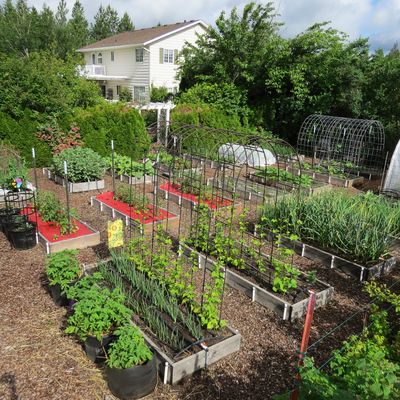In the Garden: June’s deluges rotten for some garden vegetables

I learned something interesting this spring: Too much water is definitely not a good thing when it comes to growing vegetables.
On May 1, I covered several raised beds with plastic sheet mulch in preparation for planting cucurbit family crops (cucumbers, melons, pumpkins and squash). The mulch increases the soil temperature, which helps those crops thrive. On May 16, I planted those seedlings in their respective beds, and they began to grow.
Then the rains came, filling our rain gauge with 1 to 2 inches on several occasions. I soon noticed the cucumber and melon seedlings were wilting. My first thought was, “Those darned pillbugs!” They love nibbling on the tender stems of seedlings, which kills the plants very quickly. While carefully examining them, I wasn’t able to locate any insect damage and started to wonder if it was some sort of disease that targets cucurbits.
After digging up a couple of seedlings that were at death’s door, I spotted their brownish root systems and recalled that can be a sign of too much water. We gardeners have come to think of wilting as a sign of drought stress in plants, but it also can mean the exact opposite. I soon noticed the tomato plants were looking pathetic, as well.
I shut off the water timer to the garden for a few days and, sure enough, the plants began to perk up. Once I reseeded the cucumbers and melons that didn’t make it, the garden as a whole was back on track.
The other veggie plants are doing well. It’s time for me to thin the root crop seedlings to a 3-inch spacing. This includes beets, carrots, parsnips and turnips. This simple but important task gives the plants more room to develop their delicious roots.
The corn plants are coming along nicely and will definitely exceed the annual “knee-high by the 4th of July” target. A few of them didn’t get off to the best of starts courtesy of a visiting porcupine that decided it’d be OK to lumber up and over them. Thank goodness we had set aside 20 extra seedlings because that is exactly how many plants were snapped in half.
Starting our lettuce patch earlier was a good idea because we’ve been enjoying salads for several weeks. I sowed the seeds indoors in early March and then transplanted them outdoors under a cover. There’s also sorrel growing in the lettuce bed. After hearing a friend rave about how delicious it is, we decided to plant some, too, and now we’re hooked. A moment after biting into a leaf, our taste buds are treated to a citrusy burst of flavor. Sorrel makes a delightful addition to salads and can be substituted for spinach.
The pea vines are starting to develop pods, as are the fava beans. Both plants are so beautiful, and in addition to providing us with tasty peas and beans, they fix nitrogen in the soil.
This year, we are growing all of our potatoes in containers. Someone recently asked why we were doing that, and I had to sheepishly admit it was because I ran out of raised beds to plant them. The line of large pots and cloth grow bags are overflowing with the potato plants, and I have to admit it’s an easy way to expand the footprint of one’s garden.
Now the garden is on cruise control. Life is good.
In this week’s “Everyone Can Grow a Garden” video, I answer readers’ questions on growing vegetables. You can find it at youtube.com/c/susansinthegarden.